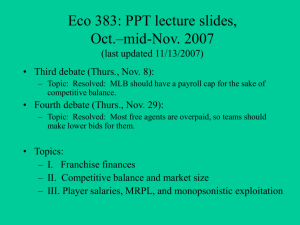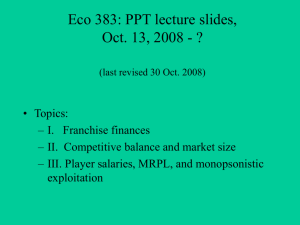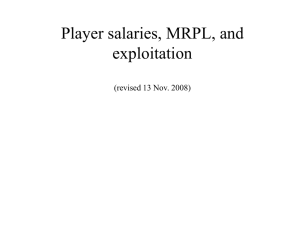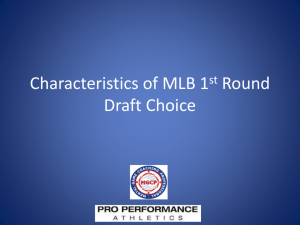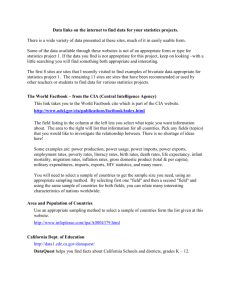The Economics of Baseball
advertisement
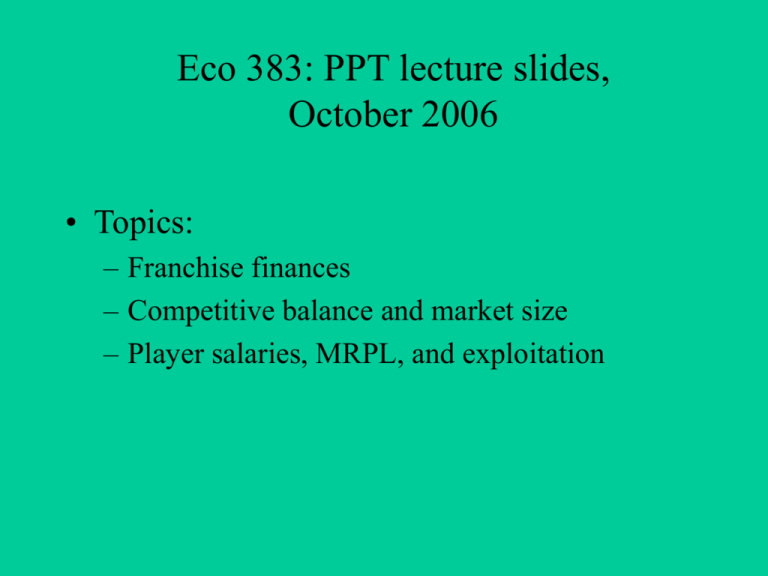
Eco 383: PPT lecture slides, October 2006 • Topics: – Franchise finances – Competitive balance and market size – Player salaries, MRPL, and exploitation Franchise finances: An introduction • Why we care: – (1) To draw a conclusion about the health of the industry (MLB), we need to know about the health of individual firms (teams). – (2) Issue of whether the small-market teams can afford to field competitive teams. • If too many teams cannot compete, then demand for MLB will tend to fall. MLB’s 2000 report concluded that... • (1) 27 of the 30 MLB teams had cumulative operating losses in 1995-99. • (2) Small- and mid-market teams can’t compete, because they can’t afford to field very good teams. Computing team profits • OPERATING PROFIT • = total revenues total costs • same as “operating income” • what we focus on • reported in Forbes (1997-), Financial World (1990-96) • PRE-TAX PROFIT • = operating profit interest costs* “player depreciation” • < operating profit • declared to IRS • (* interest costs could be from purchase of team, stadium debt…) Ways to hide a team’s profits • Claim “depreciation” of your players as a loss (over 5 years, up to 50% of what you paid for the team; legal under U.S. tax law). • Deduct the interest paid on team-related loans. • Related-party transactions: If you own another company that does business with the team, overcharge your team (or pay it too little) in those deals. • Featherbedding: Pay yourself (and friends and relatives) an excessive salary and claim it as a cost. Breakdown of team revenues (Forbes, 1998) • 40% tickets & suites • 34% broadcasting • 12% food, merchandise • 7% ads, sponsorship • 6% other Other Ads… Food… B'cast… Tickets… 45 40 35 30 25 20 15 10 5 0 Breakdown of team costs In rough descending order of importance • Player salaries (~55% in 1992-2001) • Scouting & player development (farm teams…) • “General and administrative” / Team operations – (front office, manager, coaches…) • • • • Marketing, publicity, ticket operations Stadium operations Contributions to MLB central fund (MLB revenue-sharing; sums to $0) Estimated profitability of MLB teams (source: Forbes) Year % increase in asset value Operating profit (and return on assets) 1999 $1.0 million 6% (0.5% of assets) (6.5%) 2000 $4.3 million 12% (1.8% of assets) (13.8%) 2001 $2.5 million 10% (1.0% of assets) (11.0%) 2002 -$1.3 million 3% (-0.5% of assets) (2.5%) Estimated profitability, cont’d Year % increase in asset value Operating profit (and return on assets) 2003 -$1.9 million 3% (-0.7% of assets) (2.3%) 2004 $4.4 million 15% (1.5% of assets) (16.5%) 2005 $12.1 million 15% (3.7% of assets) (18.7%) (Note: best measure may be long-term increase in asset value.) Calculating a team’s (one-year) return on assets (ROA) ROA = % increase in estimated team value + (operating profit as % of previous year’s team value) Note well: Because operating profit is usually a very small fraction of team value, ROA will usually be very close to the one-year percent change in team value. To calculate ROA from the Forbes table ROA = (Operating income) (1 year change in value) + -------------------| (Current value) | | ---------------- | | 1+(1 year change)| (Tip: Compute in decimal form, then convert to %.) Ex.: NY Yankees: Value: Current value (May 2006) = $1026 M Value: 1 year change = 8% (or .08) Operating income = -$50.0 M – --> ROA = .08 + (-50.0)/[(1026/1.08)] – = .08 + (-50)/(950) – = .08 + (-.053) – = .027, or 2.7% Is the sky falling on MLB financially? • YES, say owners and commissioner (most notably in 2000-02) • Selig: for 2001, a $232 M operating loss & a $519 M book loss • 2000 report said 5 of 13 franchise sales in 1992-2000 were at a loss – Selig: “We’ve run out of ‘greater fools’ ” – weak resale market in 2001-02 • Lately, Selig and owners are less negative, thanks in part to current CBA • NO, say most independent researchers • Forbes: for 2001, a $75 M operating profit • Franchises normally sell at big profits; high rates of asset appreciation – Weak resale market in 2001-02 was temporary and due to sluggish economy. What a difference a year makes: Baseball finances in 2003, 2004, & 2005 2003 2004 2005 average operating profit (as % of assets) number of teams with positive operating profit -0.7% +1.5% +3.7% 15 20 25 number of teams whose estimated value rose 17 28 30 Media ownership of teams • Ownership of teams by media companies, esp. TV stations, complicates the profit picture. – Media companies often buy teams as programming content, not as separate investments; synergy strategy. – Large operating losses may be OK if media company’s own profits go up. • Two media companies recently sold their teams. – (Fox) News Corp. sold Dodgers, Disney sold Angels – Time Warner looking to sell Braves? – MLB teams as unprofitable corporate divisions? Criteria for investments, and how MLB teams stack up • Rate of return (appreciation of asset value) – – – – 12.4% in 1960-2002 (John Moag) 8% in 1950-2000 (Rodney Fort) 9% from time of purchase to 2004; average of 23 teams (Forbes) stocks (benchmark): 6.9% in 1960-2002 • Safety (lack of risk) – Forbes, April 2004: 16 of 23 teams had long-term gains of 9% or more; 4 had gains of 5-7%; 2 had gains of 2-3%; one had loss of 2% – Operating losses are usually small but not uncommon. – stocks: returns are highly variable and often negative; but, can diversify. • Liquidity (convertibility into cash; resellability) – poor; selling a team takes many months if not years – stocks: very liquid, easy to resell • Cash flow – Minimal in relation to size of investment (ditto for stock dividends). – But, can be negative (whereas stockholders have limited liability). What is competitive balance? • Blue Ribbon Panel report (2000): competitive balance exists when – “there are no chronically weak clubs because of MLB’s financial structural features” – a well-managed club has a reasonable hope of reaching postseason play and winning • (implies that finances and market size should have minimal effect) Why is competitive balance an economic issue? • The demand for MLB will tend to fall if-– too many teams cannot compete – fans perceive that the richest teams have an unfair advantage Simple measures of competitive balance • Standard deviation of team winning percentages • Number of WS or pennant winners, in comparison with-– number of teams in league – previous years or intervals • Average number of games out of first place? MLB’s competitive balance, then & now • • • • 1903-1950s: not much, but gradually improving 1965-1976: improved more; amateur draft helped 1977-early 1990s: peak of competitive balance 1995-2001: competitive imbalance? – Regular season: strong correlation between payroll and W-L % – Postseason: • all WS winners were from top 25% of payrolls • only 4 teams from bottom 50% made postseason, won 5 games • 2002-2006 WS winners and payroll rank: – Angels (15th-highest), Marlins (26th) – Red Sox (2nd) – White Sox (13th), Cardinals (11th) or Tigers (14th) What is “market size”? • Market size is based on REVENUES (both actual and potential). • Revenues are very dependent on the quality of the team’s product (wins, players, stadium, etc.), but also on local factors like – area population – area per-capita income – area level of interest in baseball (hard to measure) • Hard to separate team factors from local factors, actual from potential market size Two crude measures of market size • TOTAL REVENUES, as compared with the other MLB teams • ESTIMATED TEAM VALUE, as compared with the other MLB teams – more forward-looking, e.g., higher if team is about to move into new stadium • Which teams are “large market” (~top 4?), “midmarket,” “small market” (~bottom 5?)? • Market size perhaps cannot be measured precisely Can the small-market teams compete? MAYBE • First 15 years of free agency (1977-91) saw unprecedented parity, several successful smallmarket teams • Insignificant correlation between payroll and W-L % through mid-1990s • Recent success of some small-market teams • Market size is not static MAYBE NOT • Yankees: 4 WS titles in 5 years (1996-2000) • 1997-2006: statistically significant correlation between payroll, W-L % • 1992-2006: Only one small-market, low-payroll team has won WS • Collapse of Montreal Expos (well-run smallmarket team) Competitive balance in recent decades • Recall: – 1977-early 1990s: peak of competitive balance – 1995-2001: some pattern of competitive imbalance • Explanations: – Free agency (post-1976) helped comp. balance • Easier for also-rans to improve themselves with new talent • Rising salaries --> harder to keep championship teams intact – Growing revenue and wealth imbalance in 1990s • Growing importance of local media and stadium revenues – Value of MLB’s national TV deal fell 60% in 1994 • Increasing corporate (esp. media) ownership of teams Competitive balance in other pro sports • (NFL) National Football League: highest comp. balance – low concentration of championships (but MLB’s is lower now) – policies: ~70% of revenues are shared; hard salary cap; “unbalanced” schedule – lowest correlation between payroll and performance • (NHL) National Hockey League: ?????? – Pre-2004: in the middle: • low concentration of championships (1991-2002: 8 different teams) • little revenue sharing, no luxury tax, no salary cap • lower payroll-performance correlation than MLB or NBA – 2004-05: season-long lockout by owners, who got a salary cap • (NBA) National Basketball Association: least balanced – high concentration of championships (1991-2002: just 4 teams) – increasing standard deviation of win percentages since 1980 The English Premier League (PL; soccer) • League membership not fixed (non-monopolistic) – no territorial rights • London: 9 PL teams since 1990 • Within the league, a hierarchy of divisions – bad high-division teams are relegated (demoted) – good low-division teams are promoted to higher ones • Comp. balance is mixed – good in terms of standard deviation of win percentages, upward mobility of teams – high championship concentration (Manchester United) How can be MLB’s competitive balance be increased? • Payroll cap / luxury tax? – Payroll cap might work, but is not feasible • Players’ union willing to strike to prevent one. • Owners have not asked for one since 1995. – MLB has a luxury tax on large payrolls, but threshold is too high to be binding for most teams • Increased revenue sharing? – Could work, but details are key: • What if teams use accounting tricks to hide revenues? • Incentive for low-revenue teams to improve themselves? – Part of current (2002-2006) Collective Bargaining Agreement. Player performance and salaries News flash: MLB players are highly paid • Average MLB salary = $2.87 M (April 2006) – Up 8.9% from previous year – About 10 times as high as in 1983 – Less than NBA ($4.5 M in 2003) – More than NHL ($1.6 M), NFL ($1.3 M) (in 2003) • Median MLB salary = $1,000,000 – Fluctuates a lot more than the average • Was $975,000 in 2000, fell to $800,000 in 2003 – 409 players making $1 M+, fewer than in 2000-2002 marginal revenue product of labor (MRPL) • = the amount of revenue that an employee generates for his employer • standard economic answer to “How much is that employee worth?” • can be measured in yearly terms (salary), or in hourly terms (hourly wage) • marginal product of labor (MPL) = how much OUTPUT an employee produces MRP theory & player pay • First, note that athletes are not the only very highly-paid people in U.S. society • VOLUNTARY EXCHANGE = market transactions, including free-agent contracts, are agreed-upon by buyer and seller • Fort: “talent is hired to produce [wins] in the long run.” – perhaps more than just wins... – Mark McGwire, 1998: extra MRPL of $15M? A labor market under perfect competition: Assumptions • Many buyers, many sellers -- nobody has market power • No restrictions on pay or employment • No cartels among employers, no unions • Diminishing returns --> downward-sloping demand curve for labor • Upward-sloping supply curve for labor Notation (goes with blackboard notes): • • • • • L = # of workers ( = QL = quantity of labor) w = wage ( = PL = price of labor) SL = supply of labor DL = demand for labor MRPL = marginal revenue product of labor – MRPL = the amount of revenue that an additional worker generates for the firm Economic exploitation • MONOPSONY: a labor market with just one buyer • ECONOMIC EXPLOITATION • = difference between a worker’s marginal revenue product and his wage • = MRPL - w • In a monopsonistic labor market: • w < MRPL • w < w* (competitive wage) When the baseball players’ labor market was a monopsony • Until 1976, when all players were under the reserve clause. • RESERVE CLAUSE: a provision in baseball’s rules that allowed owners to renew a player’s contract automatically for one year. – Players either re-signed with their teams after each season or retired (or were traded or released). – No free agency; no competitive bidding for players. – Held salaries down; average salary = $25,000 in 1969. Independence Day • July 1976: new Basic Agreement gives all players free agency after 6 years of service. – Salaries surged after 1976; up 42% in 1976-77 – Can use monopsony diagram to illustrate Baseball’s current system Year of ML service Eligible for… 1st - 2nd Rookie minimum ($327,000 in 2006) 3rd - 6th Salary arbitration After 6th Free agency The amateur draft • MLB’s annual selection of the top amateur talent in the U.S. – – – – Conducted each June. Worst teams draft first. A player can deal only with the team that drafts him Monopsonistic market. In effect since 1965. • Before 1965, teams just signed amateur players as free agents. – Competitive market – Signing bonuses were often quite high. – Once the draft began in 1965, signing bonuses dropped dramatically. Baseball’s salary explosion, 1976-present • “Freedom and prosperity” • Shift from monopsony to competitive bidding was less sudden than it seems – Over time, more and more teams played the FA market – Collusion against FA’s held salaries down in mid-1980s • Salary arbitration (1973-) allowed 3rd-to-6th-year players to piggyback on FA salary scale • MLB revenues surged -- attendance rose, TV revenues soared, stadium revenues soared, ... Comparison of performance (MRPL) and salaries: • “Exploitation index” (EXPL) = MRPL/salary – Alternatively, “pay-for-performance index,” salary/MRPL • Zimbalist estimated this with 1986-89 data – How to measure MRPL? For hitters, the one common statistic with the highest correlation with team winning percentages is... “OPS” (On-base Plus Slugging pcts.) • = On-base percentage (OBP) + Slugging percentage (SLG) • = what Zimbalist uses a measure of hitters’ productivity, in computing MRPL’s – --> next steps: • estimate the player’s contribution to team winning percentage, based on wins as a function of OPS • estimate contribution of additional wins to team revenues Comparison of performance (MRPL) and salaries: • Younger players tend to be “exploited” (pay<MRPL) • Players with 6+ years of experience tend to be “overpaid” (pay>MRPL) Salary/MRPL, by service category (1986-89) Salary/MRPL, Year of service Category on average 1st - 2nd “apprentice” 16 – 25% (highly exploited) 3rd - 6th “journeyman” 50 – 64% (exploited) th After 6 “master” 140% (overpaid) Salary/MRPL: 2003 update (Source: Bill Felber of Total Baseball) Years of service Salary/ MRPL 1-2 27% 3-6 49% 7+ 156% How do we explain those systematically “overpaid” veterans? • Supply and demand: Even though most free agents are past their prime, teams still have holes to fill and supply of free agents is limited mediocre free agents can command top dollar • Also of note: – Stats-based MRPL measure may be too narrow -doesn’t count leadership, reputation, marquee value – Free-agent contracts are often long term reduced incentive to work hard?
